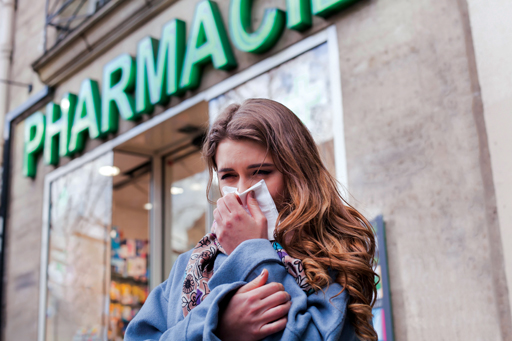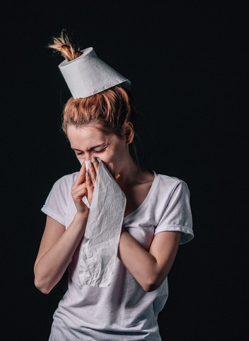Winter ailments: Help cut the queues
In Clinical
Follow this topic
Bookmark
Record learning outcomes
The winter months provide the perfect opportunity for pharmacy to drive home the self-care message and ease the pressure on GP surgeries and A&E departments.


Learning objectives
After reading this feature you should be able to:
- Support customers to self-care when they have common winter ailments
- Help customers find the products that suit their requirements
- Run a successful flu vaccination programme in your pharmacy.
Research by the Proprietary Association of Great Britain indicates that, despite good intentions, many people do not know how to self-treat conditions such as coughs and colds and therefore visit their GP or A&E for advice.1 GSK estimates that one-fifth of GP consultations concern minor ailments, including cold and flu symptoms, which costs the NHS around £370 million a year.
Pharmacies need to be aware of the crucial role they can play in educating customers about relieving symptoms of minor winter ailments, says Kate Knapik, pharmacist manager of Whitworth Pharmacy in Brigg, Lincolnshire.
“In my pharmacy we prepare monthly displays about particular subjects. A winter health display could be a perfect opportunity to promote self-care for colds, coughs and other winter ailments. Look out for printed leaflets and booklets that can be displayed on a healthy living pharmacy display table and handed out to customers or attached to prescription bags.”
Winter campaigns by both GSK and RB are encouraging customers to self-care when suffering from cold and flu symptoms. “Given our leading position in cold and flu, we feel it is important to use our brands’ equity to encourage patients to self-care this winter,” says RB marketing manager Kate Sweeney. “The range of formats we offer across Strepsils, Lemsip and Nurofen Cold & Flu provides a wealth of choice, helping patients to take care of their symptoms.”
Discussing GSK’s £7.5 million media investment in the winter remedies market, area marketing manager Andy Mahony says the company is on a mission to help reduce the burden on NHS resources by accelerating cold and flu self-care. “We hope our investment will help to raise this awareness, making it easier for shoppers to find the right product to treat their symptoms.”
“Every opportunity should be taken to talk to customers about boosting the immune system through proper nutrition, regular exercise and supplementing vitamin C, zinc and other important nutrients,” says Kate Knapik. “And don’t forget the message about antibiotic resistance and why antibiotics are not effective for viral infections.”
Organise your fixtures
Graham Phillips, superintendent pharmacist of the Manor Pharmacy Group, Hertfordshire, says the cough and cold season is the time to reorganise fixtures in your pharmacy with a clear merchandising plan featuring beacon brands in both the P and GSL sections.
You really need to think about the winter season and make a proper planogram, he says. “We use one that provides a merchandising tool on a tablet, so that any member of staff can scan the fixture and see what it should look like. Make sure that you feature the national bestsellers, as these beacon brands act as visual clues for customers and direct them to the products they are looking for.”
There needs to be some offers that make the pharmacy look competitive, he says, and it is crucial that staff are trained to provide advice on seasonal ailments and OTC products. “We have an evidence-based formulary and put people through the standard WWHAM questions but also use a broader mnemonic called ‘Sit Down Sir’* because it asks a wider range of deeper questions.”
Staff should also deliver public health messages by reminding customers to have a flu jab and, for example, when selling cough medicine finding out if the customer is a smoker and whether they would like help to quit. “When talking to a customer about their particular concerns, it is important your team member has given them all the relevant advice they may need. That includes asking customers if they are taking any medication prescribed by their GP when recommending an OTC product.
They won’t necessarily think the water tablets they are taking for their blood pressure are important but they could react with the decongestant in a cold remedy and cause problems. This could be a cue for the pharmacist to check through their medication records to ensure they are getting appropriate advice.”
Medications for minor winter ailments: Quick crammer...
Oral analgesics. Analgesics and antipyretics help to reduce pain and fever associated with sore throats and colds. Ibuprofen also reduces inflammation, which can help if sinuses are inflamed. Paracetamol and ibuprofen can be used in conjunction with one another but should be taken two to three hours apart for maximum benefit.
Decongestants (e.g. oxymetazoline, xylometazoline, phenylephrine and pseudoephedrine) help to reduce nasal congestion by constricting the dilated blood vessels in the nasal mucosa. This reduces swelling and oedema of the nasal mucosa, making it easier to breathe. Decongestants are not suitable for pregnant and breast-feeding women and patients with hypertension. Nasal sprays and oral tablets should not be used concurrently.
Combination products can contain ingredients such as a decongestant, analgesic, cough suppressant, antihistamine or an expectorant. These can be used up to their maximum dose for up to seven days unless they contain sedating antihistamines, when they should only be used for up to three days. Antihistamines work by drying up nasal secretions and should be used with a decongestant as they are relatively ineffective on their own. They can also cause drowsiness, so are often found in combination products to aid insomnia associated with having a cold.
Inhalants, vapour rubs and saline products. Inhalants work by helping to clear the nasal passages, while steam inhalation will help ease nasal congestion by loosening mucus. Saline preparations relieve congestion by helping to liquefy mucous secretions. Inhalants, rubs and saline products can be used daily until symptoms are cleared. They can be used as an alternative by patients who cannot tolerate decongestants.
Sore throat treatments. Most sore throats are caused by a viral rather than a bacterial infection, so don’t need antibiotics. Medicated lozenges or anaesthetic sprays can help relieve the symptoms of sore throat. Gargling regularly with an antibacterial mouthwash or warm, salty water can reduce any swelling and inflammation, while sucking pastilles or lozenges will stimulate saliva secretion to lubricate the throat and help relieve irritation.
Cold sore treatments. Cold sores usually clear up without treatment within seven to 10 days but antiviral creams, such as aciclovir or penciclovir, can be used to ease symptoms and speed up the healing time. Antiviral tablets are generally more effective than creams at treating severe cold sores, but are usually only prescribed in more intractable cases. Patches that contain a hydrocolloid gel can be placed over the cold sore to hide the affected area while it heals.
Customers don’t stock up on cold & flu remedies
Shoppers are twice as likely to keep a supply of pain relief medication than they are to stock up on cold and flu remedies, according to new research.
Fifty-four per cent of shoppers only buy cold and flu remedies when they immediately need to use them, making them little more than a distress purchase, according to research by category and shopper management specialist Bridgethorne.
Only 27 per cent said they keep a supply in advance of a flu occurrence, with 11 per cent buying opportunistically whenever they see a good deal. (Online shoppers were twice as likely to buy cold and flu remedies when they see them on promotion.) Two-thirds of respondents said they buy cold and flu products within hours of having to use them.
The survey reflects the “very different shopper missions of consumers when it comes to buying cold and flu remedies”, says Bridgethorne head of research, Andy Grout. “Not only did the survey find that the last cold and flu relief purchase was made in-store by 92 per cent of shoppers, but also that, of those who usually only buy their groceries online, two-thirds still bought their last cold and flu remedy in a bricks and mortar store, he says. “This supports the idea that cold and flu remedies are largely a distress purchase.”

Comfort brands
The report also showed that shoppers took comfort in familiar brands. “The highest brand penetration went to Lemsip, Vicks, Nurofen, Beechams, Strepsils and Benylin,” says Grout. “There was some variation by channel, with online-only shoppers more readily buying A. Vogel herbal remedies, Night Nurse/Day Nurse, Boots’ own brand products and Nurofen.
“Less well-known brands also appear to be gaining more traction online than offline, with purchases of Puressentiel and Covonia more prevalent amongst shoppers online than in-store.”
More than half of the shoppers questioned (56 per cent) said they bought whatever they came across in-store “in their hour of need” that claimed to do the job needed. In-store visibility, ensuring the product was displayed during the right timeframe and early in the store journey is therefore key, he says. “Only a small minority seek advice or conduct a price check online before buying.”
For those who do seek online advice, Boots, the NHS [e.g. NHS Choices] and Google were the primary sources, the study found.
Shoppers were not always “instantly aware or conscious of the sources which influence them”, Grout explains, but when prompted they recalled the value of face-to-face advice – from friends or the pharmacist – and other trusted sources. “Getting to grips with the way shoppers shop and the impact across different retail formats is as important for brands as it is for the [retailers] themselves.”
The survey also found that adults in the 35-44 year age group were the most likely to consult a pharmacist, and often not for themselves, but with the health of a child, partner or relative in mind. This demographic, the survey found, also judged live online chats as a valuable source of advice.
The 18-34 year-olds were no less likely to consult an in-store pharmacist about a cold and flu product, but made greater use of health bloggers. They also used the NHS online as a source of information more than any other age group and placed a greater reliance on the advice of family and friends.
More than other shoppers, those in the 45-64 year age group tended to make purchases ahead of time in anticipation of the winter season, but also purchased as soon as symptoms became apparent.
Flu warning
Community pharmacies delivered nearly one million flu vaccinations last year and could play a crucial role again this winter in preventing a possible flu epidemic.
Key facts
- Community pharmacies delivered nearly one million flu vaccinations last year
- The average per pharmacy was 113 vaccinations but three contractors managed over 1,000 each
- It is important to get the whole team involved in promoting the service to maximise uptake
Simon Stevens, chief executive of NHS England, warned recently that Australia and New Zealand had experienced their worst ever winter flu outbreak, caused by the virulent H3 virus. He said global transmission could soon see the virus circulating in the UK.
According to the Australian Health Department, there were 2.5 times more flu diagnoses this year than in 2016. Rates were highest in adults over 80 years with a secondary peak in young children aged five to nine years.
Flu is one of the main causes of emergency admissions during the winter and NHS Providers, which represents hospital trusts, has already warned that hospitals currently do not have sufficient capacity to manage this winter safely.
With this in mind, the pharmacy flu vaccination service provides a great opportunity to make a real difference in communities, says Deborah Evans, who is managing director of the training and consultancy business Pharmacy Complete. “At this time of funding challenges, it has never been more important for pharmacies to deliver a productive flu jab season and demonstrate value. There was a phenomenal uptake of the service in pharmacies last year and we are expecting a bigger uptake again this year.”
Community pharmacies administered 950,765 flu vaccinations to patients under the national scheme in 2016/17, more than a third more than the previous season. More than 70 per cent of pharmacies (8,451) offered the service delivering, on average, 113 vaccinations per pharmacy although three contractors completed over 1,000 vaccinations each. (As this issue went to press, the number of vaccinations delivered by community pharmacy this season had passed the 500,000 mark.)
Alastair Buxton, PSNC director of NHS Services, says the fact that the number of vaccines administered in pharmacies has been going up year after year shows how keen the public is to access services that have traditionally been provided in other settings.
“Community pharmacy has shown once again that even during difficult times there is a real appetite across the sector to do more to offer patients and local communities more clinical services and to contribute to the public health agenda.
“Flu vaccinations have been a real success, but there is much more that we could do to both improve patient care and ease the burden on other healthcare providers. As the NHS struggles to manage demands, we hope its leaders will be taking note.”
Pharmacy offers enormous benefits when providing this service to its customers, says Deborah Evans. “You are offering them convenience, you are protecting the local community through herd immunity and you are able to vaccinate carers as well. It is also good for the pharmacy team because this is a clinical role and this makes the public take pharmacy more seriously.”
It is crucial that pharmacy teams are trained to effectively drive recruitment and promote the flu service, she says.
Flu service top tips include:
- Get the whole pharmacy team involved in promoting the service to maximise uptake
- Make sure the team understands how the service will benefit both patients and the business
- Talk to every patient:
- Initiate conversations on prescription hand-out, asking all eligible patients if they have booked an appointment yet with their surgery
- Offer a jab there and then
- If this is not possible, let the patient choose a vaccine appointment – but be aware some patients won’t turn up to a pre-booked appointment. Take a phone number and contact them to re-arrange in the event of a ‘no show’
- Ensure all staff have done their relevant training and that the pharmacist’s Declaration of Competence has been completed
- Advertise the service – put up posters about getting a flu jab in the pharmacy
- Make sure the consultation room looks clean and clinical Ensure all staff know the processes involved – you don’t want patients to lose confidence in the service by having team members who don’t understand the process and who pass them from pillar to post until there is someone who can help them.
Protecting antibiotics
Point-of-care testing for C-reactive protein (CRP) has shown promise as a measure to reduce unnecessary antibiotic prescribing in respiratory tract infections. Studies show that in countries where they regularly do CRP testing it reduces unnecessary use of antibiotics, says Graham Phillips.
“I would like to see CRP testing routinely available in community pharmacy, followed by prescribing an antibiotic under a PGD or through referral to a GP. There is a huge potential role here for pharmacies to play in saving GP time by appropriate referral and avoiding unnecessary over-prescribing of antibiotics,” he says.
Antibiotic misuse remains a huge concern. “Antibiotics should not be given for viral infections but often still are, partly due to patient demand,” says Royal Pharmaceutical Society president Ash Soni. “It is easy to pick up an infection and once ill, people often visit their GP to request antibiotics because they think they are not getting better quickly enough, when in fact infections can last longer than you might think.”
The average duration of typical common infections is:
- Sore throat: 7-8 days
- Ear infection: 8 days
- Common cold: 14 days
- Sinusitis: 14-21 days
- Cough or bronchitis: 21 days.

Taking sore throats as an example: the vast majority are viral infections that don’t respond to antibiotics – but almost half (46 per cent) of those sore throat sufferers surveyed by Ultra Chloraseptic had been prescribed antibiotics and almost a third (30 per cent) had been advised to use antibiotic throat lozenges. As a result of the Department of Health’s five-year strategy to reduce resistance, 2 million fewer prescriptions were written for antibiotics in 2015 – but that is a cut of only 7.9 per cent.
It is important, therefore, that pharmacy teams educate customers that antibiotics will not cure viral winter respiratory infections, and that self-care and OTC products are the best way to relieve symptoms.
Handy tips
The RPS received widespread media coverage recently when it recommended singing “Happy Birthday to you” twice when washing hands. The suggestion followed a survey showing that 84 per cent of British adults don’t wash their hands for long enough to cleanse them of the bacteria that could cause infections, such as upset stomachs or pneumonia, or viruses that can cause colds and flu.
The survey also showed that:
- 2 in 3 people (65 per cent) don’t always wash their hands before eating
- 1 in 2 people (50 per cent) don’t always wash their hands after handling animals, such as pets
- 1 in 3 people (32 per cent) don’t always wash their hands before preparing food
- 1 in 5 people (21 per cent) don’t always wash their hands after going to the toilet.
“Preventing infection through better handwashing is essential to protect ourselves and others from becoming unwell,” says Ash Soni. “If we can reduce the number of illnesses where antibiotics are needed, we can reduce antibiotic resistance by saving these important medicines for when they are really required.”
Could it be COPD?
When people come into the pharmacy with coughs, colds and symptoms
of breathlessness, they could have undiagnosed COPD...
As well as picking up undiagnosed COPD cases, pharmacy teams also play a key role in supporting patients with existing disease, which can be exacerbated during cold weather, says Mark Stone, pharmacist practice partner and independent prescriber.
There are around 835,000 patients currently diagnosed with COPD, which means an average pharmacy will have approximately 60 patients who can be supported with medicines, he says.
“COPD patients often fare worse during the winter months but making sure that they have a rescue pack [of medication] at home can be a massive help, says Well pharmacist Sadik Al Hassan. “The rescue pack could contain prescription antibiotics and steroids to help manage the condition, and an OTC recommendation to accompany these would be a vitamin C preparation or a multivitamin like Berocca that could reduce the duration of infection by up to two days.
“If COPD patients are too ill to visit the pharmacy to pick up their prescription, then it might be worth reminding them about a home delivery service.”
Pharmacists can also optimise medicines by checking inhaler technique and adherence to medication, provide smoking cessation support and help early detection of signs of exacerbation, adds Mark Stone. They should also make sure patients understand how to use their rescue medication and have had their flu and pneumococcal vaccinations, he says.
Mark has produced a pharmacy COPD consultation toolkit,3 which can be downloaded from the Devon LPC website.
And don’t forget...
Coughing and sneezing can be problematic for those who experience light bladder weakness. Stress urinary incontinence (SUI) occurs when the bladder unexpectedly leaks due to pressure from physical exertion such as coughing or sneezing. The amount of leakage tends to be small but will depend on the fullness of the bladder at the time. For women, this is the commonest type of bladder weakness but it can also affect men.
Dropping temperatures can disturb the functionality of the pelvic floor, making it harder for muscles to warm up and contract. This can cause unexpected leakage, particularly in the elderly, so advise them that keeping warm and active can have a positive effect on bladder weakness of this kind.
REFERENCES
1. Self Care Nation: Self care attitudes and behaviour in the UK. November 2016 PAGB
2. Flu service top tips. Liverpool LPC
3. COPD consultation toolkit. Devon LPC
* Site of symptoms, Intensity of symptoms, Type/nature, Duration, Onset, With (other symptoms), Annoyed or aggravated by? Spread of symptoms? Incidence of symptoms? Relieved by?
The cough and cold season is the time to remerchandise the winter fixtures
